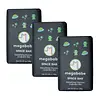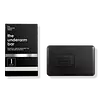What's inside
What's inside
 Key Ingredients
Key Ingredients

 Benefits
Benefits

 Concerns
Concerns

 Ingredients Side-by-side
Ingredients Side-by-side

Sodium Cocoate
CleansingWater
Skin ConditioningGlycerin
HumectantCoconut Acid
CleansingSodium Citrate
BufferingCharcoal Powder
AbrasiveGlycolic Acid
BufferingMelaleuca Alternifolia Leaf Oil
AntioxidantPersea Gratissima Oil
Skin ConditioningHelianthus Annuus Seed Oil
EmollientCamellia Sinensis Leaf Extract
AntimicrobialOlea Europaea Fruit Oil
MaskingAscorbic Acid
AntioxidantAloe Barbadensis Leaf Juice
Skin ConditioningSodium Gluconate
Skin ConditioningSodium Chloride
MaskingMaltodextrin
AbsorbentSodium Cocoate, Water, Glycerin, Coconut Acid, Sodium Citrate, Charcoal Powder, Glycolic Acid, Melaleuca Alternifolia Leaf Oil, Persea Gratissima Oil, Helianthus Annuus Seed Oil, Camellia Sinensis Leaf Extract, Olea Europaea Fruit Oil, Ascorbic Acid, Aloe Barbadensis Leaf Juice, Sodium Gluconate, Sodium Chloride, Maltodextrin
Sodium Palmate
CleansingSodium Palm Kernelate
CleansingWater
Skin ConditioningGlycerin
HumectantSodium Chloride
MaskingCoconut Acid
CleansingCharcoal Powder
AbrasiveMethyl Salicylate
PerfumingMentha Viridis Leaf Oil
AstringentMenthol
MaskingRosmarinus Officinalis Leaf Oil
MaskingSodium Gluconate
Skin ConditioningCocos Nucifera Oil
MaskingVinegar
Butyrospermum Parkii Butter
Skin ConditioningPentasodium Pentetate
Tetrasodium Etidronate
Emulsion StabilisingCitric Acid
BufferingSodium Palmate, Sodium Palm Kernelate, Water, Glycerin, Sodium Chloride, Coconut Acid, Charcoal Powder, Methyl Salicylate, Mentha Viridis Leaf Oil, Menthol, Rosmarinus Officinalis Leaf Oil, Sodium Gluconate, Cocos Nucifera Oil, Vinegar, Butyrospermum Parkii Butter, Pentasodium Pentetate, Tetrasodium Etidronate, Citric Acid
 Reviews
Reviews

Ingredients Explained
These ingredients are found in both products.
Ingredients higher up in an ingredient list are typically present in a larger amount.
Charcoal powder comes from grounded charcoal. Charcoal can originate from peat, bamboo, coal, wood, coconut shell, or petroleum.
This ingredient has absorbent properties, making it great at absorbing oil.
Coconut Acid isn't fungal acne safe.
Glycerin is already naturally found in your skin. It helps moisturize and protect your skin.
A study from 2016 found glycerin to be more effective as a humectant than AHAs and hyaluronic acid.
As a humectant, it helps the skin stay hydrated by pulling moisture to your skin. The low molecular weight of glycerin allows it to pull moisture into the deeper layers of your skin.
Hydrated skin improves your skin barrier; Your skin barrier helps protect against irritants and bacteria.
Glycerin has also been found to have antimicrobial and antiviral properties. Due to these properties, glycerin is often used in wound and burn treatments.
In cosmetics, glycerin is usually derived from plants such as soybean or palm. However, it can also be sourced from animals, such as tallow or animal fat.
This ingredient is organic, colorless, odorless, and non-toxic.
Glycerin is the name for this ingredient in American English. British English uses Glycerol/Glycerine.
Learn more about GlycerinChances are, you eat sodium chloride every day. Sodium Chloride is also known as table salt.
This ingredient has many purposes in skincare: thickener, emulsifier, and exfoliator.
You'll most likely find this ingredient in cleansers where it is used to create a gel-like texture. As an emulsifier, it also prevents ingredients from separating.
There is much debate on whether this ingredient is comedogenic. The short answer - comedogenic ratings don't tell the whole story. Learn more about comegodenic ratings here.
The concensus about this ingredient causing acne seems to be divided. Research is needed to understand if this ingredient does cause acne.
Scrubs may use salt as the primary exfoliating ingredient.
Learn more about Sodium ChlorideThis is the synthetic salt of gluconic acid, a form of PHA and mild exfoliant.
It is mainly used to stabilize oil and butter formulations from going bad. Sodium gluconate is a humectant, pH regulator, and chelating agent.
Chelating agents help neutralize unwanted metals from affecting the formulation.
Sodium gluconate is water-soluble.
Learn more about Sodium GluconateWater. It's the most common cosmetic ingredient of all. You'll usually see it at the top of ingredient lists, meaning that it makes up the largest part of the product.
So why is it so popular? Water most often acts as a solvent - this means that it helps dissolve other ingredients into the formulation.
You'll also recognize water as that liquid we all need to stay alive. If you see this, drink a glass of water. Stay hydrated!
Learn more about Water